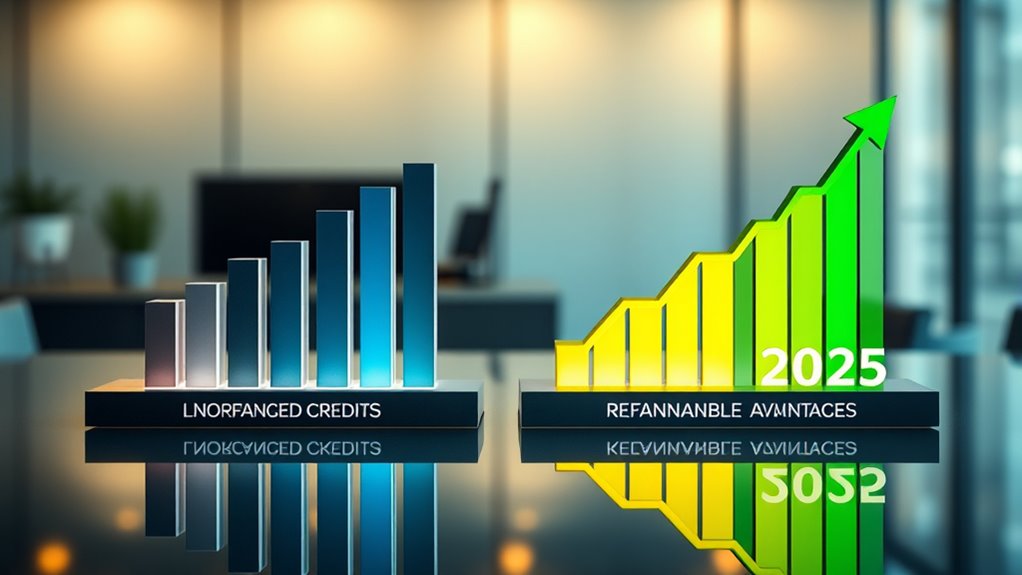In 2025, significant updates will clarify eligibility for both nonrefundable and refundable credits. Nonrefundable credits can lower your tax bill to zero but won’t generate a refund, while refundable credits can do so, even if your tax is already zero. Many credits will face phase-outs at higher incomes, and some will expand to help more families and low-income earners. To maximize your benefits and understand the new rules, there’s more to explore below.
Key Takeaways
- 2025 updates clarify eligibility criteria and may expand refundable credits like the Child Tax Credit and Earned Income Tax Credit.
- Nonrefundable credits will face phase-outs at higher income levels, affecting taxpayers’ eligibility.
- Refundable credits can create refunds beyond tax owed, providing more benefit to low-income households.
- Changes aim to improve financial support for families and low-income earners through expanded eligibility.
- Understanding the distinctions helps optimize tax planning and maximize available credits in 2025.

Understanding the difference between nonrefundable and refundable credits is vital when preparing your taxes. These credits directly impact your tax bill but in different ways, so knowing how they work can help you maximize your benefits and avoid surprises. Nonrefundable credits can only reduce your tax liability to zero. If the credit exceeds what you owe, the remaining amount doesn’t carry over or get refunded to you. Conversely, refundable credits can reduce your tax bill below zero, meaning you could receive a refund even if you didn’t owe any taxes initially. Recognizing these distinctions is essential for effective tax planning, especially as new rules and thresholds come into effect in 2025. Additionally, the impact of these credits often depends on the projector technology used in your home setup, which can influence your overall financial planning. Tax implications are significant when considering these credits. With nonrefundable credits, you need to be aware of the eligibility criteria that determine whether you qualify. These criteria often depend on your income level, filing status, or specific circumstances like education expenses or energy-efficient home improvements. If you meet the eligibility criteria, you can claim the credit, but if your tax liability is too low, you might not get the full benefit. Refundable credits, on the other hand, can offer more flexibility because they’re less dependent on your current tax liability. They can provide a direct cash benefit, making them especially valuable for lower-income taxpayers or those who don’t owe much in taxes but still qualify for these credits. In 2025, some updates aim to clarify eligibility criteria for certain credits and expand their reach. For example, changes in the Child Tax Credit or Earned Income Tax Credit could make more taxpayers eligible or increase the amount they can claim. These modifications are designed to enhance financial support for families and low-income households, ensuring more people benefit from these refundable credits. Meanwhile, nonrefundable credits are also getting adjustments to phase out at higher income levels, affecting how much you can claim depending on your income. It’s important to stay aware of these updates because they influence your tax planning and whether you qualify for specific benefits. Ultimately, understanding whether a credit is refundable or nonrefundable and knowing the eligibility criteria helps you make informed decisions during tax season. By keeping up with the latest changes in 2025, you can guarantee you’re claiming every benefit you qualify for and avoiding potential pitfalls. Whether you’re aiming to reduce your overall tax bill or maximize your refund, recognizing these differences allows you to strategize effectively and avoid leaving money on the table. Staying informed about the tax implications of each credit type is your best tool for a smoother, more advantageous tax filing experience in the upcoming year.
Frequently Asked Questions
Are There Any New Eligibility Requirements for Credits in 2025?
In 2025, you’ll find new eligibility requirements for credits based on income limits and filing status. You need to meet specific income thresholds, which vary depending on your filing status, to qualify for certain credits. These updates aim to target benefits more effectively. Make sure you review the new income limits and filing status rules to determine if you’re eligible, as failing to meet them could disqualify you from receiving these credits.
How Do State-Specific Credits Compare to Federal Credits in 2025?
You might be surprised how state-specific credits differ from federal ones in 2025. State incentives often target local priorities, like renewable energy or education, offering unique benefits. While federal credits follow general rules, state credits can vary widely, requiring strategic tax planning to maximize benefits. Don’t overlook these local incentives—they could substantially reduce your tax bill or open new opportunities that federal credits alone don’t provide.
Can Nonrefundable Credits Be Carried Over to Future Years?
Yes, nonrefundable credits can be carried over to future years if you don’t use the full amount due to credit limitations. You should check your specific state’s carryover options, as some states allow longer carryovers or different rules. Keep in mind that federal nonrefundable credits generally have strict carryover limits, often just one year, so plan accordingly to maximize your benefits.
What Documentation Is Needed to Claim Refundable Credits?
To claim refundable credits, you need to provide specific documentation that supports your eligibility, such as proof of income, identification, and any relevant forms like Schedule 8812 or Form 8867. You should follow the claim procedures carefully, ensuring all required documentation is complete and accurate. This helps the IRS verify your eligibility quickly, so gather your tax records, receipts, and prior-year returns to streamline the process.
How Will Tax Software Updates Affect Claiming These Credits in 2025?
In 2025, tax software updates will streamline claiming refundable and nonrefundable credits through improved tax software integration. You’ll find that eligibility verification becomes more efficient, reducing errors and speeding up the process. The software will automatically check your qualification for these credits, guiding you through the necessary steps. This means you’ll spend less time on manual calculations and more confidence in accurately claiming all eligible credits, ensuring maximum benefits with ease.
Conclusion
So, whether you’re dreaming of a tax refund or just trying to dodge the IRS’s grasp, understanding these credits is your new best friend—or cunning foe. As 2025 shakes things up, remember: nonrefundable credits might leave you empty-handed, while refundable ones could fill your wallet—if the stars align. Just don’t get too comfortable; the tax code’s game of chess is always one move ahead. Stay sharp, and may your credits be ever in your favor.








